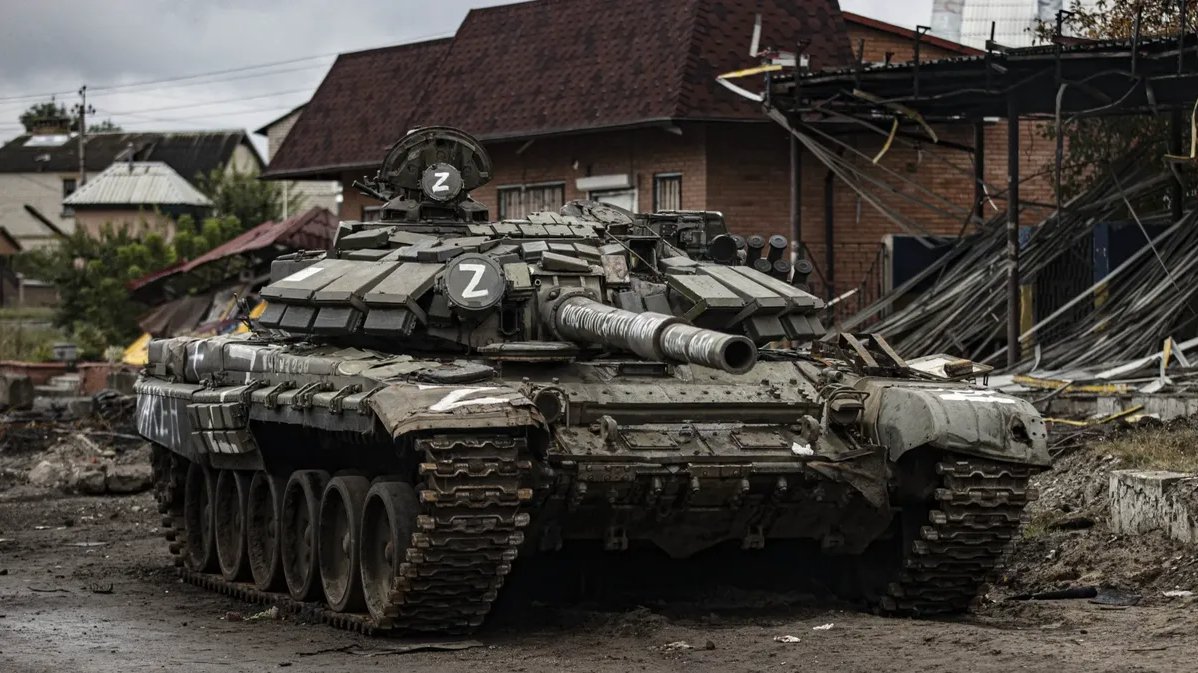Dmitry Medvedev, Russia’s former president and currently the deputy chairman of the Security Council inspected Uralvagonzavod, one of Russia’s leading military production facilities, on 25 October. As Medvedev said himself, he was inspecting the tank production situation in particular. On his Telegram channel, he wrote about the objectives that were set up during an offsite meeting: acceleration of the equipment supplies to Russia’s troops in Ukraine, strict execution of the state defence order in all its key parameters, and preventing supplies disruption. Medvedev’s main message after visiting the complex, however, was for the foreign readers of his channel: “One more thing. Reading the enemy’s analytics, I have come across multiple claims that Russia will soon be out of military equipment and essential weaponry. They say we’ve wasted all of it. Don’t hold your breath. Our production of weaponry and special equipment is increasing many-fold in all domains: from tanks and artillery to high-precision missiles and drones. Just wait for it!” Almost 5 trillion rubles (€81.3 billion) invested into Russia’s defence budget for 2023 are at stake here.
Novaya Gazeta Europe has analysed whether Medvedev’s words regarding the “many-fold” increase in the production of tanks and other military vehicles can be put into practice. Military experts and employees within Russia’s military industry have helped us in doing so. Since such a co-operation would put them at risk, triggering “fake news” and “army discreditation” charges in the best possible scenario, we’re forced to cite the sources still based in Russia on the condition of anonymity.
Unprepared for war
“The people who started the ‘special military operation’ have been trampling down Russia’s defence sector for many years,” a source within the Russian military industry tells Novaya-Europe. “When Putin came to power, a redivision of the market started. The old top brass was eliminated and replaced by the new ‘efficient management.’ Those factories that had some of their manufacture exported to other countries managed to keep their affairs afloat. In fact, exports are the only thing that kept the military industry alive. The factories that lacked exports potential were either destroyed or sold off. Some of the buildings have been turned into shopping malls, others were simply abandoned.
The profit margin is minimal when it comes to state defence order, Novaya-Europe’s source says. This is Soviet legacy: back in the day, the product price was calculated as the prime cost plus a minor revenue mark-up, say, 5 to 15%. If a tank was sold to a different country for 2.5-3 million dollars, Russia’s Defence Ministry would only return 1 million to the factory’s budget on a good day. These circumstances meant that it was unprofitable for the factories to work with the state and the state defence order. Our source recalls Kurganmashzavod (a vehicle plant based in Kurgan, Russia, known for producing BMP infantry fighting vehicles — translator’s note) failing to comply with the state defence order for several years straight but in the meantime dutifully selling its BMP-3 fighting vehicles to the UAE and Malaysia.

The Kurgan Vehicle Plant a.k.a Kurganmashzavod. Photo: kmz.ru
Some factories, specifically those manufacturing commercially viable products for exports, took out loans to buy equipment from banks in the West. However, after the Crimea annexation and the Western sanctions that followed it, they were forced to switch to Russian banks, falling into debt bondage. Some factories were on the verge of bankruptcy. The matter is being addressed these days, and a debt restructuring programme at the expense of the state budget is a possible option.
Military research, development and engineering also lacked state financing in Russia, as the source says.
“It is common practice in the US when their Defence Ministry pays money to the factories, expecting prototypes of certain products in return,” an employee within the Russian military industry says. “This might as well be a competition, and two companies would be working on one order at the same time. They both would then receive money from the Defence Ministry. The latter would test both and start serial production of the better one. It works the other way around here, they say: guys, go work at your own expense! Those few lucky ones who receive financing anyway are interested in wasting time deliberately, putting off the final result as long as they can to keep getting the money. Therefore, Russia’s factories find it beneficial to keep manufacturing old but tried and tested produce, using the Soviet stocks and avoiding major production risks.”
There is no innovative, science-driven produce in Russia these days, and it should not be expected to appear anytime soon, the expert believes.
“It is obvious that Russia’s army is in catastrophically short supply of almost all types of equipment,” an employee for Rostec, a state-owned defence conglomerate, says. “This is why the government orders the factories all over the country receive are so urgent. It seems as if the new priority now is all about quantity, not quality. In simpler words, it’s unimportant which tanks are being sent to the frontlines: the newest T-90M models or the recommissioned T-62 ones.”
The Rostec employee says Uralvagonzavod received a state order of 400 tanks shortly after the Ukraine War started. As per the factory’s public relations office, the tanks production line there has a full load of work up until 2024. However, after Russia started massively losing its equipment on the frontlines, the deadlines must have been seriously tightened up.
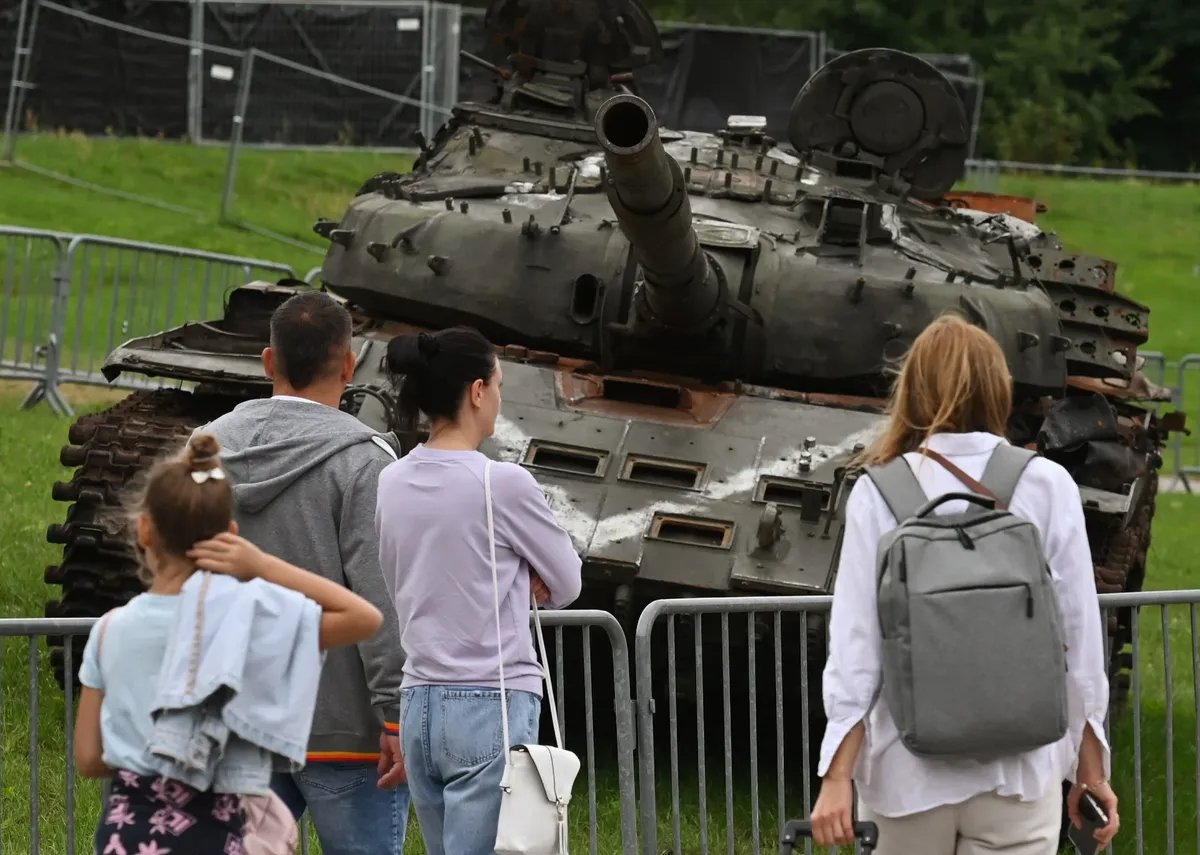
A partially destroyed T-72BA Russian tank captured by Ukraine’s army on an exhibition in Gdańsk, August 2022. Photo: Artur Widak / NurPhoto / Getty Images
However, even in the tank industry, the instructions from the highest management cannot be executed immediately.
“Everyone was unprepared for a war. Launching any sort of production requires time. First and foremost, all suppliers, selectors and allied manufacturers should be dealt with,” the Rostec employee says. “Producing tanks requires metal, guns, engines, electronics, communication devices and all sorts of other complex mechanisms and integral units. All those things were purchased based on the actual contracts and cannot be acquired in a snap of a finger. There were no stocks, too; we have a lean manufacturing policy.
Handmade tanks
Our source working for one of the state corporations in Russia estimates the current Uralvagonzavod’s production capacity at 200–250 tanks a year. The footage of Medvedev’s visit indicates that the new tanks are being assembled manually, and the old ones are being modernised on the stocks. Notably, the old Soviet assembly line provided an annual capacity of thousands of tanks each year. The workers at the factory make jokes that their tanks are handmade as they speak to the Novaya-Europe reporter unofficially.
Stepping up production requires production space expansions. However, those tens of billions of rubles allocated to build state-of-the-art workshops capable of automatically assembling Armata tanks have been “used up” already. Uralvagonzavod pursues its contractors in court, and not a single square metre of new workspaces has been constructed. The purchased equipment and the expensive imported machines lie rotting in crates for years. This is why no mass production of Armata tanks is to be expected in the foreseeable future. Meanwhile, Alexander Potapov, Director General at Uralvagonzavod, has not been held accountable for scuttling one of the most ambitious projects of Russia’s military industry.
As a result, Armatas are being assembled in the same section of the factory as T-90s and T-72, fundamentally heavier and bigger models, although there is no relevant equipment for that. It is unknown how many Armatas are in operation now, it’s safe to assume that about a dozen of them used for military displays at the Red Square, plus a few vehicles, were provided to certain units for training. For instance, an Armata tank was seen in Kazan’s Higher Tank Command School.
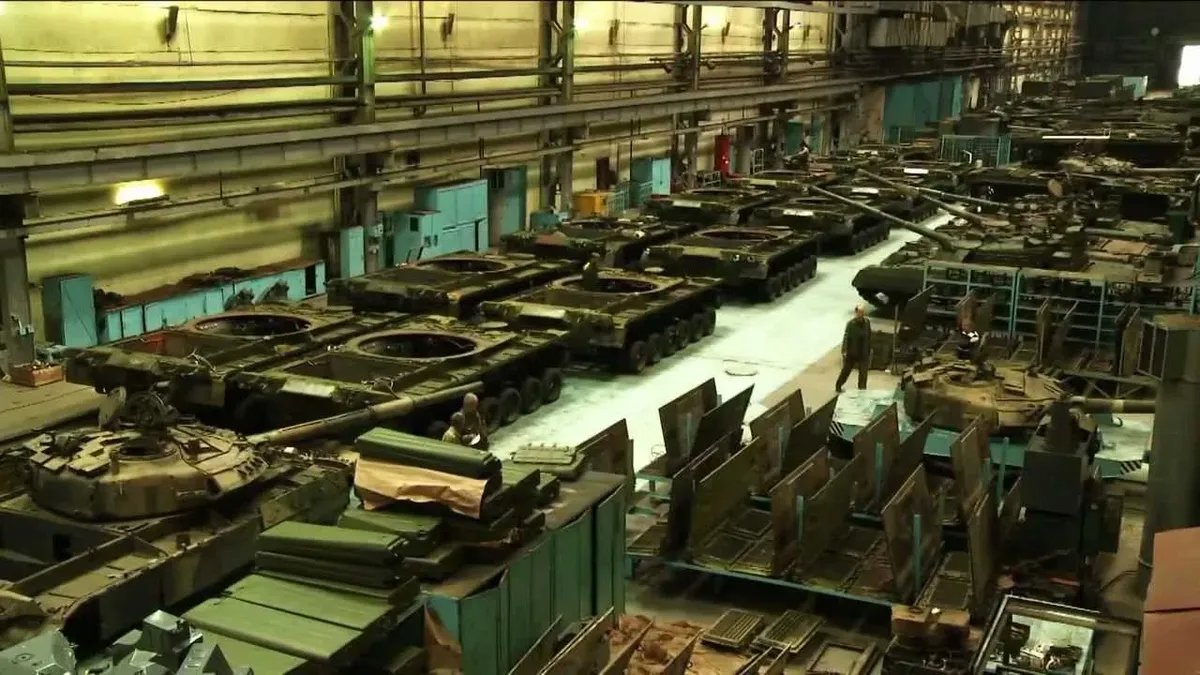
Tank production line at Uralvagonzavod. Screenshot from a YouTube video
Uralvagonzavod lacks trained assembling specialists to set up a new production line within the existing workspaces. To step up production, the factory would need to hire more people. These days, the factory’s schedule is three shifts, seven days a week, same as most military industry facilities.
Uralvagonzavod used to deliver tanks in dozens but handing in a batch of 5 or 10 tanks to the army is somewhat common these days. The factory is now focused on producing T-72B3M tanks, although a set of modern T-90M appeared on the Internet recently. Ukraine’s servicemen have already captured some of those. It’s difficult to make up a worse marketing campaign than the newest Russian tanks getting put out of action using old rocket launchers and anti-tank missiles.
Russia’s Defence Ministry might be in possession of up to eight thousand tanks of different models, from T-62 to T-80, preserved in storage, as per Volya, a Telegram channel. Volya tried to figure out how many tanks are in Russia’s use, and found out that up to 90% of the depreserved vehicles require mandatory modernisation. According to the channel’s calculations, Russia’s tank industry is currently capable of producing up to 250 new vehicles and modernising up to 600 old ones each year.
Terminators under repair
Ukraine is outweighing Russia more and more on the frontlines in terms of firepower owing to the NATO-supplied long-range gun systems capable of delivering fire at a distance of 30-40 km. The 2S19 Msta, Russia’s most advanced self-propelled howitzer, is only capable of firing a projectile at the distance of 24 km. Such a small distance (by today’s terms) was designed because old projectiles were supposed to be used, and Russia had those galore. Therefore, the potential increase in shooting distance is limited by the weapon’s ballistics. There is another one: the 2S35 Koalitsiya-SV is the newest Russian howitzer, capable of hitting a target of up to 70 km away from its location. Russia started designing it in the late 1990s, and it also has an autonomous turret with increased fire rate. However, UralTransMash has only produced several prototypes so far, and there are no such vehicles on the front lines.
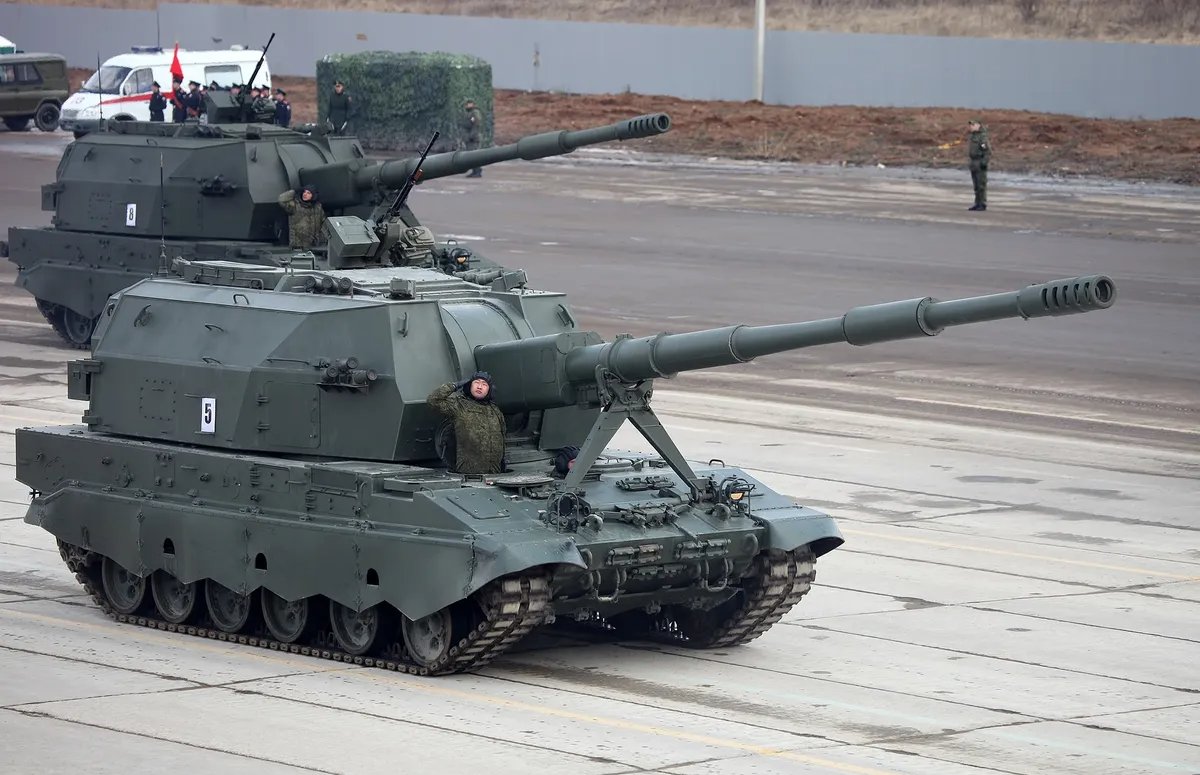
A 2S35 Koalitsiya-SV during the rehearsal of the Victory Day parade, Alabino near Moscow, 11 April 2016. Photo: Wikimedia
Novaya-Europe’s source in Rostec says that the Armata and the 2S35 Koalitsiya-SV share the same problem regarding the gun system: Russia does not produce the required type of gun steel. Only two factories in Russia produce blanks for parts of the receiver group: the Motovilikha Plants in Perm and Barrikady, a machine manufacturing plant in Volgograd.
“Russia’s metal industry is dead,” our source says. “When a competition for barrel blanks was announced, all the samples put up for it turned out to be defective. The special thing about the new barrels is that they must withstand greater pressure, that is, be more durable. This requires special alloys and melting modes, as well as small-sized furnaces. The thing is: Russia’s metallurgy is focused on large volumes and mass grades of steel.
Back in the day, some of the managers within the industry considered that the open-hearth smelting process had become inefficient, and all open-hearth furnaces were extinguished in the country. However, only those furnaces could produce high-quality steel, including the one used to produce artillery.
Another much-touted product of Uralvagonzavod is the Terminator tank support combat vehicle sold to Algeria in commercial quantities. Four of those vehicles were seen in Ukraine, which pleased Russia’s patriotic public. However, in the next video, posted about a month later, the vehicles were filmed undergoing repair.
Iskanders not laughing anymore
It is generally believed that Russia has a strategic stockpile of Iskanders, Kalibrs and other modern missiles.
“Russia’s Defence Ministry does not provide any data on the number of equipment produced, used in the theatre of operations or lost there,” Pavel Aksyonov of BBC explains to Novaya Gazeta Europe. “For instance, we can only estimate how many missiles are manufactured in Russia by indirect signs: by the number of missiles launched and by the selection of missiles. During the massive missile attacks on Ukraine which followed the blowing up of the Crimean bridge, Tornado S, S-300, Kh-101, Kh-55, Kalibr and Iskander missiles were used, as well as UAVs, and so on. At the same time, there is still no data on the number of missiles of each type that were taken down or hit targets in Ukraine.
A contact for Novaya-Europe who works in the development of missiles reports that many types of missiles, such as Kalibr, are being immediately sent from the production lines to the launch points.
Russia’s Defence Ministry reported that a total of 99 missiles had been launched on targets in Syria between 7 October 2015 and 3 November 2017.
“An ordinary US destroyer ship carries over 90 cruise missiles. And they have dozens of those,” our source says. “Russia has nothing of this kind. They use corvettes and frigates, which only have 8 or 16 launchers. In a year’s time, the nuclear cruiser Admiral Nakhimov (former Kalinin), which has been under modernisation since 1999, is expected to return to combat duty. It will be converted to launch modern missiles.”
Another reason to doubt the sufficiency of Russia’s high-precision missiles is the use of S-300 anti-aircraft systems against ground targets. Such missiles are guided quite imprecisely when used in the ground-to-ground mode. Moreover, a powerful fragmentation warhead leads to numerous casualties among the unprotected civilian population when it hits a residential area.
The Kinzhal missile system, which Putin used to scare the West with, is the same Iskander model attached to a MiG-31 fighter-interceptor jet. Russia has very few such missiles, our sources say, same as MiG-31 jets modified to carry those: there are only several planes, to be specific.
“Also, the Kh-22 anti-ship missile with a homing head was used during the attacks on Ukraine,” a rocket engineer says. “Simply put, it is able to tell a block of metal in the form of an aircraft carrier from the flat sea. It cannot, however, pick the right building out of many in an urban landscape. In this case, it flies using the pre-determined navigation route and arrives somewhere in the vicinity of the target, quite imprecisely, in fact. The possible deviation in this case is hundreds of meters at best.”
According to our contact, Russia does not have the production capacity to manufacture the missiles to replace those already used. Back in 2018, the crew at the Dubna Machine Building Plant protested against the management methods of AFK Sistema which owned the enterprise. Russia hauled away the equipment from Ukraine’s Dnipro in the early 2000s and placed it at the plant in Dubna, where the production of the Kh-series missiles was launched. According to our source, Almaz-Antey, which produces Kalibr, S-300 and S-400, has issues with the imported machines that have stopped working due to the sanctions.
Corruption is the cause
Since the Soviet times, Russia’s aviation design bureaus have had a surplus of fundamental research in aerodynamics. For instance, Russia’s latest aircraft, the Su-57, have an excellent glider. But Russia’s electronics are larger and less reliable, which increases the weight of the aircraft. The characteristics of radar stations, as well as communication systems, are significantly inferior to their Western counterparts. Russia’s radars have a smaller detection range, they can track fewer targets, they have worse target recognition quality, and so on. The domestic engines are also weaker in terms of technical characteristics than the Western ones. At the same time, the sources of Novaya Gazeta Europe in the military industry say that only a few of these newest Su-57 fighters can be assembled each year.
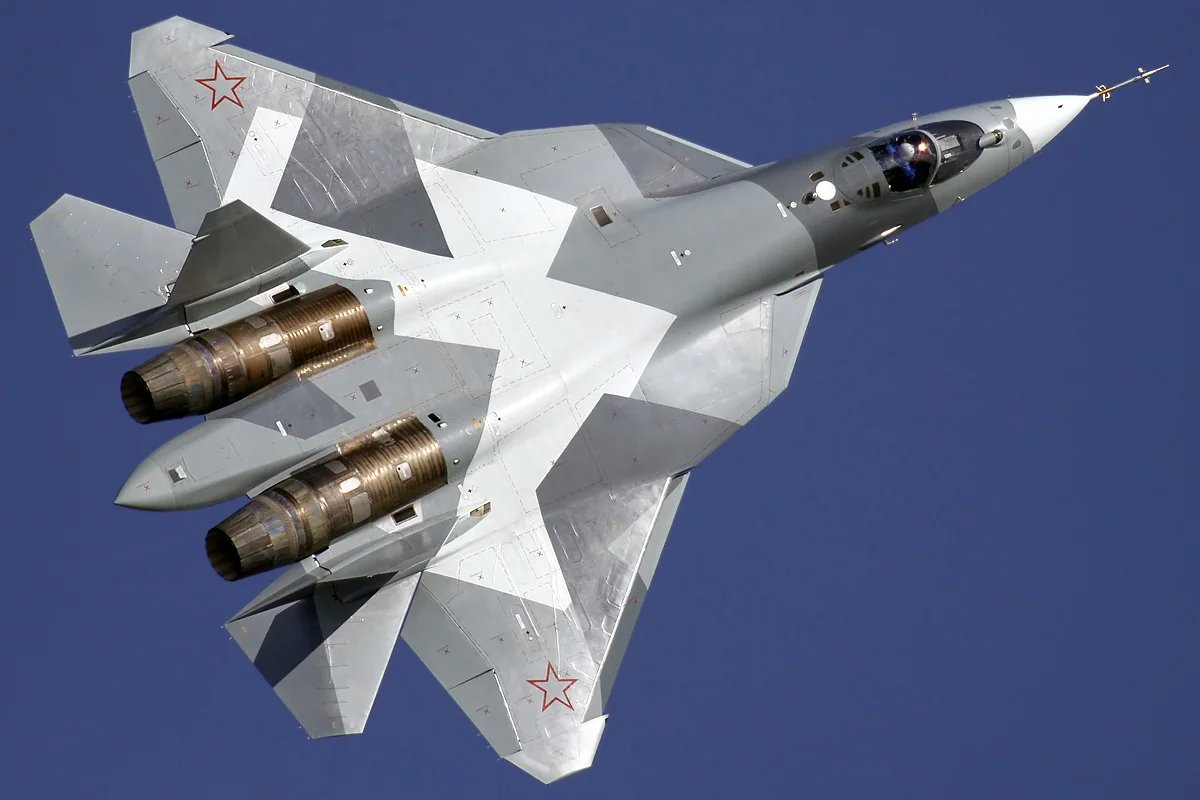
A Su-57 during a demonstration flight at the MAKS-2011 air show. Photo: Wikimedia
The situation with the helicopters is no better. America’s modern rotorcraft are one and a half times smaller and much more efficient in terms of load and weapons. In terms of their weight, size, and operational characteristics, they leave the Russian ones far behind. Russia’s helicopters consume more fuel, not to mention the fact that the engines for most models were manufactured in Ukraine. Notably, Vyacheslav Boguslaev, the head and co-owner of Ukraine’s Motor Sich PJSC, was arrested for supplying engines and spare parts for Russian attack helicopters. Russia has failed to set up their own production, and it is likely that in the foreseeable future, combat helicopters in Russia will simply cease to be produced.
Our sources say that the production of drones is a new way of stealing lots of money from Russia’s defence industry.
“The command is very poorly versed in this area,” says the Rostec expert. “The entire experience of the effective use of UAVs came exclusively from below until recently. This is how it worked: a quadcopter bought with sponsors’ money or fundraising fees appeared at the units, and the troops learned how to use it, mastered strategy, tactics, piloting combat techniques and methods of effective use. The Defence Ministry does not have a separate department that would collect, systematise, and analyse these practices. When the need arose, the military officials were more concerned about how to steal and launder money rather than how to ensure combat effectiveness.
As our source says, a lot of small firms appeared several years ago, pretending to be developing UAVs. Often, the development would mean nothing but assembly of “a flying machine” based on a Chinese drone, which was then lobbied through people in the army command as the latest domestic development. Russia literally does not produce any low-power aircraft engines, be it reciprocating or jet ones. Such engines have a special thing about them: a certain ratio of dead weight to useful power is required. Electric motors, like those that the Chinese put on copters, are also not produced in Russia. But the top brass was thrown dust into their eyes, which eventually forced them to buy drones off Iran and to import large blocks and parts from China for their own promising models.
All our sources agree upon the point that Russia started the war with an industry that had failed to modernise. The money allocated on this modernisation was spent inefficiently. The Western sanctions leave zero chance for Russia to produce new developments.
“On the other hand, the T-62 is a tank that is easy to use, and it is much simpler for a mobilised person to learn how to operate it than with modern vehicles,” says our source from Rostec. “If Russia runs out of those, the T-34 can be taken from pedestals, there are many of those all across the country.”
Join us in rebuilding Novaya Gazeta Europe
The Russian government has banned independent media. We were forced to leave our country in order to keep doing our job, telling our readers about what is going on Russia, Ukraine and Europe.
We will continue fighting against warfare and dictatorship. We believe that freedom of speech is the most efficient antidote against tyranny. Support us financially to help us fight for peace and freedom.
By clicking the Support button, you agree to the processing of your personal data.
To cancel a regular donation, please write to [email protected]
